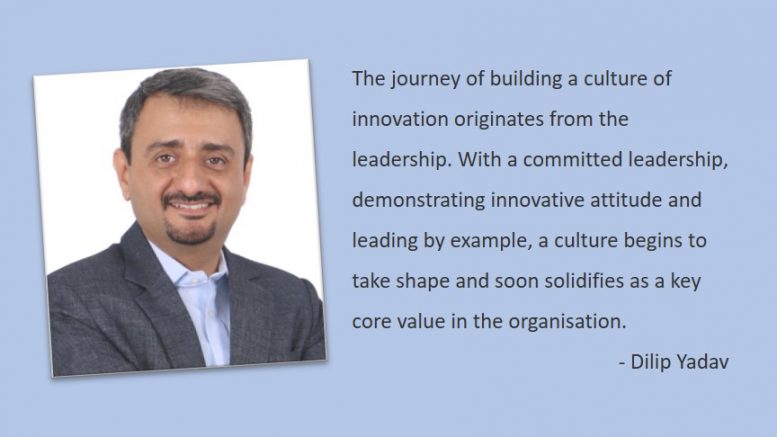Culture eats strategy for breakfast.
– Peter Drucker
This famous quote by the late management guru Peter Drucker recently sparked an online debate primarily for two reasons. First, because of its excessive popularity. It has procreated numerous seminars, management lectures, and boardroom consultations in the last 11 years on how great business strategies won’t work without a supportive culture. Second because of the controversy surrounding its source. This quote was attributed to Peter Drucker in 2006 by Mark Fields, who later went on to become the chief executive of Ford Motors; but it does not appear in any of his 39 books! Irrespective, it drives home a very important point – those who can successfully blend business strategies into the culture of an organisation will triumph ultimately.
Innovative brands have an undisputed edge in today’s fast paced business environment. In a world where innovation is the only source of relevance, organisations need to institutionalise it to be able to survive into the future.
Start at the top, go everywhere
Talking of innovative companies, it is hard to think of brands without their leaders who personify innovation. Innovation is deeply associated with the genius of the leader at the helm. The leader and the brand are like two sides of the same coin.
The journey of building a culture of innovation originates from the leadership and it is rarely the other way around. With a committed leadership, demonstrating innovative attitude and leading by example, a culture begins to take shape and soon solidifies as a key core value in the organisation. Innovative leaders are not obsessed with quarterly growth, immediate market share metrics, or even employee productivity. Be it global brands like Google, Apple, Microsoft or ITC, Wipro, ICICI, ISRO in India, the seeds of greatness and glory were sowed by the leadership. However, organisations are perpetual entities, they live beyond their leaders. Organisations which have endured beyond their founders and leaders did so because they were able to build a culture of innovation. Therefore, culture assumes greater significance, even above the leadership who initiated it.
Quo Vadis? To Communicate
To build a great culture, while a leadership ethic is indispensable, it is of the utmost importance that this same spirit expands and enthuses each member of the organisation too. The only tool which organisations have to achieve this is communication. It is in fact the central force, the elixir, which nurtures and nourishes culture-building.
Effective communication of innovative thought and action across an enterprise and amongst the employees is the only fissile material that is needed to start a chain reaction of productive innovation. It is for this reason that an able communicator with a set of precise, focused and directed communication will have a better chance at building a long-term innovative culture. In innovative organisations, none plays this role other than the founder. It is not a coincidence that successful innovative organisations are blessed with leaders who besides being good innovators are great communicators too.
The story of Apple, near bankruptcy in 1997 and now the most valuable company ever is as much a story of innovation as it is of inspiring every worker to push for more and stretch beyond the possible. Nothing motivates people to do more than being driven by an inner fire. Steve Jobs did just that. And soon, impossible goals seemed attainable, hard work was second nature, and the top of the market was just another destination to reach before the weekend.
With a committed leadership, it is important also to remember that while the top-down approach to culture development is very important, the employees themselves, as champions of change and participants in progress, play an equally, if not more, crucial part in building the innovation culture. The famous Microsoft and Google town-halls, employee days, Colgate-Palmolive’s ‘Recognition Economy’, the feedback on policy culture at Infosys, are glowing examples of how employee outreach will result in outstanding innovative growth at all levels.
Rewarding risks and failures
Another crucial plank that assists in building the Ark of innovation is inculcating a freedom of expression among all employees. This makes them fearless collaborators and partners of all and not just a select few. By communicating this freedom and encouraging constant ideation, gems are bound to emerge. Also, as in the case of Dr. Percy Spencer who invented the first microwave oven with inspiration from the melting of a candy bar in his pocket while he was working near a radar, or Jan Koum, the WhatsApp founder, who was looking for an alternative solution because he could not afford to call his father in Ukraine, you may have the next big idea just around the corner in the next cubicle.
One novel way of building a culture of innovation is by encouraging and embracing failures. Intuit hosts a company-wide award ceremony at which the “Failure Award” is bestowed on a team whose unsuccessful idea resulted in valuable learning. Eli Lily has ‘Failure Parties’. It is important that in an innovative culture of trying to do something is encouraged. This also very closely buttresses the growth of fearlessness and initiative. Building innovation as a cultural necessity is also the outcome of ably communicating the simple message that it is great to have failed but unacceptable to have not tried.
The other recommendation towards building a culture of innovation lies in the domain of organisation-wide communication of the encouragement of the entrepreneurial spirit or risk-taking. Rewarding risk-taking is simply instilling a culture of a new way of doing things. Jubilant FoodWorks has continuously endeared itself to the customers through employee-driven recommendations of change and customisation. No idea is too radical. At Google, employees are encouraged to come up with ideas that may well be risky and it’s the supervisor’s mandate to say yes to these. A ‘No’ to a new idea needs a 2-page support narrative!
Empower to endure
A people-centric structure which actively encourages employees to share the benefits so afforded, wonders begin to happen. It is helpful to imagine a culture of innovation in an organisation as an interconnected web. A living, breathing network of one-to-many, many-to-many, many-to-one communication is the new normal. The future belongs to those organisations where it is not only the leadership that is taking all the pressure to build a culture of innovation, but where each employee is creating and consuming communication simultaneously with each other to create a larger ecosystem of innovation. What Steve Jobs famously said sums it up, “You can’t win on innovation unless you have a way to communicate it to customers”.
For more conversations around Innovation (if you are an in-house communications professional), attend the Innovation First Communication Conclave in Gurgaon on Wednesday, March 14th, 2018.
The views expressed here are that of the author and do not necessarily reflect that of Reputation Today.







Be the first to comment on "Building a Culture of Innovation in your Organisation"